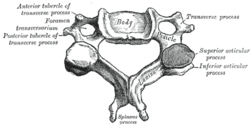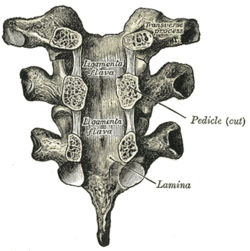Intertransverse ligament
The intertransverse ligaments are ligaments that are placed between the transverse processes of the spine.
| Intertransverse ligament | |
|---|---|
 A cervical vertebra (transverse processes labeled at upper right) | |
 Vertebral arches of three thoracic vertebrae viewed from the front | |
| Details | |
| From | Transverse processes |
| To | Transverse processes |
| Identifiers | |
| Latin | Ligamenta intertransversaria |
| TA | A03.2.01.004 |
| FMA | 13426 |
| Anatomical terminology | |
In the cervical region they consist of a few irregular, scattered fibers that are often replaced by muscles. In the thoracic region they are rounded cords intimately connected with the deep muscles of the back. In the lumbar region they are thin and membranous.[1][2]
The intertransverse ligaments often blend with the intertransverse muscles.[2]
The function of the intertransverse ligaments is to limit lateral flexion of the spine.[2]
References
This article incorporates text in the public domain from page 291 of the 20th edition of Gray's Anatomy (1918)
- "Gray, Henry. 1918. Anatomy of the Human Body". Bartleby.com. Retrieved 30 March 2013.
- "Intertransverse ligaments". AnatomyExpert. Retrieved 30 March 2013.
External links
This article is issued from Wikipedia. The text is licensed under Creative Commons - Attribution - Sharealike. Additional terms may apply for the media files.